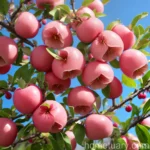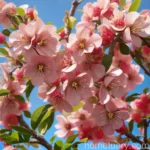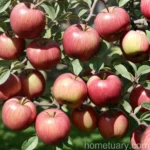Apple (Malus pumila ‘Hawaii’): A Comprehensive Guide
What is an Apple (Malus pumila ‘Hawaii’)?
The apple (Malus pumila ‘Hawaii’) is a tropical apple variety that is known for its unique and delightful flavor. This variety of apple tree, commonly referred to as the Hawaiian apple tree, is a cultivar that thrives in warm and humid climates. It is a member of the Rosaceae family and is prized for its culinary uses and ornamental value.
Key Takeaways – Apple (Malus pumila ‘Hawaii’)
- Scientific Name: Malus pumila ‘Hawaii’
- Common Name: Hawaiian Apple Tree
- Family: Rosaceae
- Cultivation: Tropical regions
- Uses: Culinary, Ornamental
- Water Requirements: Moderate
- Sunlight: Full sun
- Soil Conditions: Well-draining, loamy soil
- Pruning: Regular, maintenance pruning
- Propagation: Grafting, budding
- Common Diseases: Fire blight, apple scab
- Common Pests: Apple maggot, codling moth
Culture of Apple (Malus pumila ‘Hawaii’)
Uses
The apple (Malus pumila ‘Hawaii’) is primarily cultivated for its delicious apple fruit, which is consumed fresh and used in various culinary applications such as making juices, ciders, and preserves. Additionally, the apple tree is valued for its ornamental value, with its beautiful blossoms and foliage adding aesthetic appeal to landscapes and gardens.
Water
Maintaining appropriate soil moisture is essential for the healthy growth and fruit production of the apple (Malus pumila ‘Hawaii’). While the tree requires regular watering, it is important to ensure that the soil has good drainage to prevent waterlogging, which can lead to root rot and other health issues.
Sunlight
Apple trees thrive in full sun, requiring at least 6-8 hours of direct sunlight each day to support robust growth and fruit development. Adequate sunlight exposure also contributes to the tree’s overall health and productivity.
Fertilizer
Fertilizing apple trees is crucial for providing essential nutrients that support growth, fruit development, and overall vitality. A balanced fertilizer with a formulation such as 10-10-10 can be applied in early spring before bud break, ensuring that the tree receives the necessary nutrients.
Soil
The ideal soil conditions for the apple (Malus pumila ‘Hawaii’) include well-draining, loamy soil with a slightly acidic to neutral pH range of 6.0-7.0. Soil that is rich in organic matter and provides good aeration is beneficial for the tree’s root development and overall health.
Pruning
Regular pruning is necessary to maintain the apple tree’s structure, promote air circulation, and remove dead or diseased wood. Pruning should be carried out during the tree’s dormant period in late winter or early spring to encourage healthy regrowth and fruit production.
Propagation
The propagation of apple trees, including the Malus pumila ‘Hawaii’ variety, can be accomplished through grafting or budding techniques. These methods allow for the production of genetically identical trees with desirable traits and are commonly practiced in commercial orchards and nurseries.
Container Popularity
In suitable climates, apple (Malus pumila ‘Hawaii’) can also be grown in containers, making it a popular choice for urban and suburban settings. Container cultivation allows for greater control over environmental conditions and offers the flexibility of growing apple trees in limited spaces such as patios and balconies.
Container Common Diseases
Disease Diagnosis
Apple trees, including the Malus pumila ‘Hawaii’ variety, are susceptible to various diseases, and container cultivation may present specific challenges related to disease management. Common diseases that may affect apple trees in containers include:
- Fire Blight: A bacterial disease characterized by wilting and blackening of blossoms and shoots.
- Apple Scab: A fungal disease that causes dark lesions on leaves and fruit, leading to defoliation and reduced fruit quality.
Common Pests
Container-grown apple trees may also be at risk of pest infestations, requiring proactive pest management strategies. Common pests that can impact apple trees include:
- Apple Maggot: A type of fruit fly whose larvae infest and damage apple fruit.
- Codling Moth: The larvae of this moth species tunnel into apples, causing internal damage and increasing susceptibility to diseases.
Botanist’s Tips
To ensure the successful cultivation of the apple (Malus pumila ‘Hawaii’) and other apple varieties, consider the following tips from professional botanists and horticulturists:
- Select Suitable Rootstock: Choosing the right rootstock for grafting or budding can influence the tree’s growth habits, disease resistance, and overall performance.
- Monitor Soil Moisture: Regularly assess soil moisture levels to prevent overwatering or underwatering, as both can negatively impact the tree’s health.
- Integrated Pest Management: Employ a combination of cultural, biological, and chemical controls for managing pests to minimize environmental impact while preserving tree health.
Fun Facts
- The apple (Malus pumila ‘Hawaii’) is celebrated for its versatility in culinary applications, ranging from sweet desserts to savory dishes.
- Apple trees are known for their striking blossoms in the spring, attracting pollinators and adding colorful beauty to the landscape.
- In folklore and symbolism, the apple has been associated with various cultural and mythological references, often representing love, temptation, and immortality.
Links to External Resources
For further exploration of apple tree cultivation, diseases, and uses, the following links provide valuable information and insights:
- Apple Tree Care Guide
- Pest and Disease Management for Apple Trees
- Apple Varieties and Cultivation Practices
Conclusion
The apple (Malus pumila ‘Hawaii’) stands as a captivating tropical apple variety with its delectable fruit, ornamental appeal, and cultural significance. Understanding its cultivation, care requirements, and potential challenges equips both experienced and aspiring growers to nurture these remarkable trees with success. Whether cultivated in orchards, gardens, or containers, the apple tree remains a timeless symbol of abundance and natural beauty, enriching landscapes and delighting palates with its bountiful harvest.















